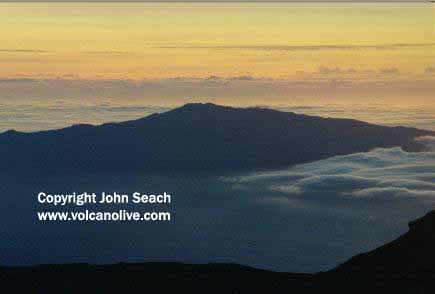Volcano Live
volcanolive.com
Hualalai Volcano | John Seach

Big Island, Hawaii
19.692 N, 155.87 W,
summit elevation 2521 m
Shield volcano
Hualalai is the westermost shield volcano on the island of Hawaii. Eruptions of Hualalai Volcano in 1800-01 occurred from 5 vents with two lava flows reaching the sea.
Hualalai began growing on the west flank of Mauna Kea about 800,000 years ago, and rose above sea level 300,000 years ago. The northwest rift zone of Hualala continues for a distance of 40 km, to a depth of 3000 m.

Hualalai Volcano from the summit of Mauna Kea volcano - John Seach
1929 Earthquake Swarm
In 1929 there was an earthquake swarm under Hualalai volcano. Several thousand earthquakes were recorded, and some were felt as far away as Honolulu. The earthquakes may have indicated magma movement under the volcano.
1800-01 Eruption
The eruption of Hualalai volcano was witnessed by a crew member from Captain Cook's voyage who had remained on the island. The eruption occurred from two vents, and produced two large lava flows. The Kaupulehu lava flow began at an altitude of between 1650-1800 m and reached the sea, destroying villages along the shore. The lava flow was 16 km long. A second lava flow began at an altitude of 500 m, and produced a spatter cone at the source called Puhiopele. The second lava flow reached the sea over a front of 6km.
North Kona Slump
North Kona slump is a landslide feature located on the west flank of Hualalai Volcano. It consists of an elliptical area 20 km x 60 km at depths 2000–4500 m.
Further reading
Cousens, B.L., Clague, D.A. and Sharp, W.D., 2003. Chronology, chemistry, and origin of trachytes from Hualalai Volcano, Hawaii. Geochemistry, Geophysics, Geosystems, 4(9).
CHEN, C.H., PRESNALL, D.C. and STERN, R.J., 1992. Petrogenesis of ultramafic xenoliths from the 1800 Kaupulehu flow, Hualalai volcano, Hawaii. Journal of Petrology, 33(1), pp.163-202.
Moore, J.G. and Clague, D.A., 1992. Volcano growth and evolution of the island of Hawaii. Geological Society of America Bulletin, 104(11), pp.1471-1484.
Hualalai Volcano Eruptions
1800-01